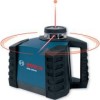Bosch GRL145HV Operating Instructions - Page 4
Warning - parts
 |
UPC - 000346387285
View all Bosch GRL145HV manuals
Add to My Manuals
Save this manual to your list of manuals |
Page 4 highlights
FCC Statement This product has been tested and found to comply with the limits for a Class B digital device, pursuant to Part 15 of the FCC rules. These limits are designed to provide reasonable protection against harmful interference in a residential installation. This equipment generates, uses, and can radiate radio frequency energy and, if not installed and used in accordance with the instructions, may cause harmful interference to radio communications. However, there is no guarantee that interference will not occur in a particular installation. If this equipment does cause harmful interference to radio or television reception, which can be determined by turning the equipment off and on, the user is encouraged to try to correct the interference by one or more of the following measures: • Reorient or relocate the receiving antenna. • Increase the separation between the equipment and receiver. • Consult the dealer or an experienced radio/TV technician for help. SAVE THESE INSTRUCTIONS Work area safety Keep work area clean and well lit. Cluttered or dark areas invite accidents. DO NOT operate the laser tool around children or allow children to operate the laser tool. Serious eye injury could result. Electrical safety ! WARNING Batteries can explode or leak, cause injury or fire. To reduce this risk, always follow all instructions and warnings on the battery label and package. DO NOT short any battery terminals. DO NOT charge alkaline batteries. DO NOT mix old and new batteries. Replace all of them at the same time with new batteries of the same brand and type. DO NOT mix battery chemistries. Dispose of or recycle batteries per local code. DO NOT dispose of batteries in fire. Keep batteries out of reach of children. Remove batteries if the device will not be used for several months. Personal safety Stay alert, watch what you are doing and use common sense when operating a tool. Do not use a tool while you are tired or under the influence of drugs, alcohol or medication. A moment of inattention while operating a tool may result in serious personal injury or incorrect measurement results. Use safety equipment. Always wear eye protection. Safety equipment such as dust mask, non-skid safety shoes, hard hat, or hearing protection used for appropriate conditions will reduce personal injuries. The correct tool will do the job better and safer. Do not use the tool if the switch does not turn it on and off. Any tool that cannot be controlled with the switch is dangerous and must be repaired. Store idle tool out of the reach of children and do not allow persons unfamiliar with the tool or these instructions to operate the tool. Tools are dangerous in the hands of untrained users. Maintain tools. Check for misalignment or binding of moving parts, breakage of parts and any other condition that may affect the operation. If damaged, tool repaired before use. Many accidents are caused by poorly maintained tools. Use the tool, accessories, etc., in accordance with these instructions and in the manner intended for the particular type of tool, taking into account the working conditions and the work to be performed. Use of the tool for operations different from those intended could result in a hazardous situation. Service Have your tool serviced by a qualified repair person using only identical replacement parts. This will ensure that the safety of the tool is maintained. Develop a periodic maintenance schedule for tool. When cleaning a tool be careful not to disassemble any portion of the tool since internal wires may be misplaced or pinched or may be improperly mounted. Certain cleaning agents such as gasoline, carbon tetrachloride, ammonia, etc. may damage plastic parts. Use and care SAVE THESE INSTRUCTIONS. Use the correct tool for your application. -4-













